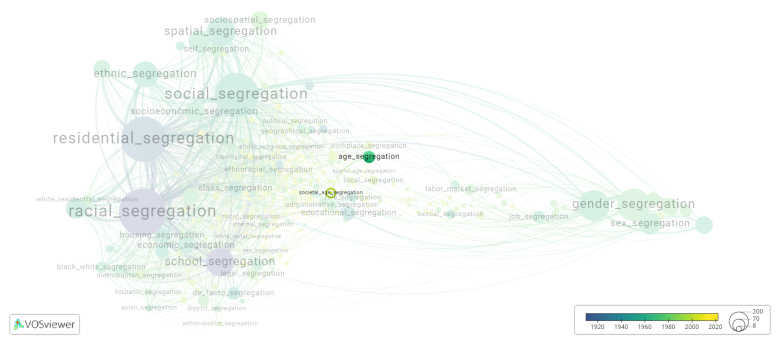Societal age segregation: Difference between revisions
(Creating page) |
(Creating page) |
||
| (2 intermediate revisions by the same user not shown) | |||
| Line 18: | Line 18: | ||
[[File:societal_age_segregation.png|780x780px]] | [[File:societal_age_segregation.png|780x780px]] | ||
This visualization is based on the study [[Segregation_Wiki:About| The Multidisciplinary Landscape of Segregation Research]]. | |||
For the complete network of | For the complete network of interrelated segregation forms, please refer to: | ||
* [https://tinyurl.com/2235lkhw First year of publication] | |||
* [https://tinyurl.com/2d8wg5n3 Louvain clusters] | |||
* [https://tinyurl.com/223udk5r Betweenness centrality] | |||
* [https://tinyurl.com/244d8unz Disciplines in which segregation forms first emerged (Scopus database).] | |||
==References== | ==References== | ||
==Notes== | ==Notes== | ||
Latest revision as of 07:17, 16 October 2024
Date and country of first publication[1][edit | edit source]
2006
Norway
Definition[edit | edit source]
Societal age segregation refers to the separation of different age groups within a society, often leading to limited contact and interaction between individuals of different ages. This can occur in various contexts, such as schools, neighborhoods, workplaces, and social settings. Age segregation can have both positive and negative effects on individuals and communities.
Positive aspects of age segregation include the ability for individuals to connect with others who are in similar life stages and to engage in activities that are tailored to their age group. For example, children may benefit from attending schools with peers of a similar age, as they can learn and socialize with others who are going through similar developmental stages.
However, age segregation can also lead to negative consequences, such as limited opportunities for intergenerational relationships and understanding. When different age groups are kept separate, there may be a lack of empathy and communication between generations, which can perpetuate stereotypes and misunderstandings.
Overall, it is important for societies to find a balance between age segregation and intergenerational connections in order to promote understanding, empathy, and collaboration across different age groups. efforts to promote intergenerational activities and programs can help to bridge the gap between generations and foster a more inclusive and cohesive society.
See also[edit | edit source]
Related segregation forms[edit | edit source]
Societal age segregation is frequently discussed in the literature with the following segregation forms:
age segregation, cultural age segregation

This visualization is based on the study The Multidisciplinary Landscape of Segregation Research.
For the complete network of interrelated segregation forms, please refer to:
References[edit | edit source]
Notes[edit | edit source]
- ↑ Date and country of first publication as informed by the Scopus database (December 2023).
At its current state, this definition has been generated by a Large Language Model (LLM) so far without review by an independent researcher or a member of the curating team of segregation experts that keep the Segregation Wiki online. While we strive for accuracy, we cannot guarantee its reliability, completeness and timeliness. Please use this content with caution and verify information as needed. Also, feel free to improve on the definition as you see fit, including the use of references and other informational resources. We value your input in enhancing the quality and accuracy of the definitions of segregation forms collectively offered in the Segregation Wiki ©.
Societal age segregation appears in the following literature[edit | edit source]
Hagestad G.O., Uhlenberg P. (2006). Should we be concerned about age segregation? Some theoretical and empirical explorations. Research on Aging, 28(6), 638-653. https://doi.org/10.1177/0164027506291872
